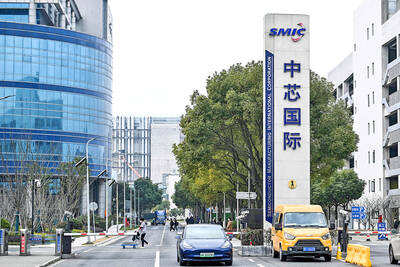Some people in the US were looking forward to more evening sunlight with daylight saving time starting today and many in the golf industry like the time change, too.
The golf workers are pushing to make the annual shifting forward of the clocks in the US permanent.
The move is intended to encourage more evening golf and to stave off efforts to establish permanent standard time, which would leave less time for an evening on the links. It is those late-afternoon players who tend to buy food and drinks in the clubhouse.

Photo: AFP
“We would lose 100 tee times a day if daylight saving time goes away,” said Connor Farrell, general manager of Stone Creek Golf Course in Omaha, Nebraska. “Switching to permanent standard time would cost us [US]$500,000 a year.”
Golf has deep roots in the history of daylight saving time, which began for most US states at 2am this morning, when clocks “spring forward” by one hour. Some credit goes to William Willett, a British builder and avid golfer who in 1905 published a pamphlet advocating for moving clocks ahead in April and returning them back to their regular settings in September. The US adopted a version of that during World War I and again in World War II.
The US Congress passed the Uniform Time Act in 1966 that set up the twice yearly time change and lobbying efforts by the golf industry are largely credited for Congress expanding daylight saving time by a month in the middle of the 1980s.
However, for as long as it has been around, the constant clock adjusting has drawn the ire of Americans weary of losing an hour of sleep in the spring only to be faced with the early onset of darkness in the fall. That exhaustion has led to hundreds of bills introduced in nearly every state over the years to halt the practice.
The US National Conference of State Legislatures reports that in the past six years, 20 states have passed measures calling for a switch to year-round daylight saving time, many at the cajoling of golf industry lobbyists.
However, while states could switch to permanent standard time — as Arizona and Hawaii have done — Congress would need to change the law to allow permanent daylight saving time.
That hindrance — along with arguments that permanent standard time would improve sleep quality and foster safer morning commutes — has seen more states consider opting out of daylight saving time. Lawmakers in more than a dozen states have introduced bills this year to make standard time permanent.
Nebraska is among several states considering competing bills to make either standard time or daylight saving time permanent.
That drew Joe Kohout, a lobbyist for the Nebraska Golf Alliance, to testify in favor of year-round daylight saving time.
Late afternoon golf leagues account for up to 40 percent of the annual revenue of some Nebraska courses, Kohout said, while a majority of golf instructors reported that nearly 50 percent of their lessons are taught after 4pm.
Under permanent standard time, “Nebraska’s golf courses will lose revenue, be forced to raise prices, and in some cases could be driven out of business,” he said.
The Utah Golf Association is also fighting a bill to make standard time permanent.
“The argument that changing clocks twice a year is an inconvenience does not outweigh the year-round benefits of having more usable daylight hours in the evenings,” it wrote on social media.
In Indiana, golf course owner Linda Rogers succeeded in lobbying the state legislature to institute daylight saving time in 2006. Now a state senator, Rogers is fighting an effort to return to permanent standard time.
“Daylight savings time allows someone that, you know, worked until 5 o’clock to come out and still play at least nine holes,” she said. “And it’s not just golf. There are so many outdoor activities that people want to be outside for and enjoy later in the summertime.”
The National Golf Course Owners Association, which has about 4,000 members, recently polled stakeholders on the matter.
The vast majority favored either permanent daylight saving time or the “status quo” of changing the clocks, association chief executive officer Jay Karen said.
Only about 6 percent backed a change to permanent standard time, Karen said.
“If standard time was to be made permanent, thousands of courses would be harmed by that,” he said.
Even so, the association is not advocating for a change to permanent daylight saving because it could hurt hundreds of courses that cater to early morning golfers, he said. Those include courses in retirement communities, vacation resorts where late tee times interfere with dinner plans and Sun Belt courses where extreme late-day heat sees golfers favoring early tee times.
“We feel like status quo is no harm, no foul,” Karen said.
Republican Iowa state Representative John Wills introduced a bill this year to make the change to permanent daylight savings, but he has been under pressure to amend the bill to permanent standard time.
Wills was considering it until he heard arguments on how that change could affect golf.
“I think I might push back in the future and say: You know, the golf industry needs this,” he said.

SEMICONDUCTOR SERVICES: A company executive said that Taiwanese firms must think about how to participate in global supply chains and lift their competitiveness Taiwan Semiconductor Manufacturing Co (TSMC, 台積電) yesterday said it expects to launch its first multifunctional service center in Pingtung County in the middle of 2027, in a bid to foster a resilient high-tech facility construction ecosystem. TSMC broached the idea of creating a center two or three years ago when it started building new manufacturing capacity in the US and Japan, the company said. The center, dubbed an “ecosystem park,” would assist local manufacturing facility construction partners to upgrade their capabilities and secure more deals from other global chipmakers such as Intel Corp, Micron Technology Inc and Infineon Technologies AG, TSMC said. It

NO BREAKTHROUGH? More substantial ‘deliverables,’ such as tariff reductions, would likely be saved for a meeting between Trump and Xi later this year, a trade expert said China launched two probes targeting the US semiconductor sector on Saturday ahead of talks between the two nations in Spain this week on trade, national security and the ownership of social media platform TikTok. China’s Ministry of Commerce announced an anti-dumping investigation into certain analog integrated circuits (ICs) imported from the US. The investigation is to target some commodity interface ICs and gate driver ICs, which are commonly made by US companies such as Texas Instruments Inc and ON Semiconductor Corp. The ministry also announced an anti-discrimination probe into US measures against China’s chip sector. US measures such as export curbs and tariffs

The US on Friday penalized two Chinese firms that acquired US chipmaking equipment for China’s top chipmaker, Semiconductor Manufacturing International Corp (SMIC, 中芯國際), including them among 32 entities that were added to the US Department of Commerce’s restricted trade list, a US government posting showed. Twenty-three of the 32 are in China. GMC Semiconductor Technology (Wuxi) Co (吉姆西半導體科技) and Jicun Semiconductor Technology (Shanghai) Co (吉存半導體科技) were placed on the list, formally known as the Entity List, for acquiring equipment for SMIC Northern Integrated Circuit Manufacturing (Beijing) Corp (中芯北方積體電路) and Semiconductor Manufacturing International (Beijing) Corp (中芯北京), the US Federal Register posting said. The

India’s ban of online money-based games could drive addicts to unregulated apps and offshore platforms that pose new financial and social risks, fantasy-sports gaming experts say. Indian Prime Minister Narendra Modi’s government banned real-money online games late last month, citing financial losses and addiction, leading to a shutdown of many apps offering paid fantasy cricket, rummy and poker games. “Many will move to offshore platforms, because of the addictive nature — they will find alternate means to get that dopamine hit,” said Viren Hemrajani, a Mumbai-based fantasy cricket analyst. “It [also] leads to fraud and scams, because everything is now